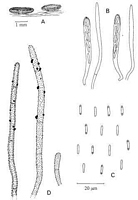|
 Lachnum pteridicola Lachnum pteridicola
SynonymsDasyscyphus pteridicola
BiostatusPresent in region - Indigenous. Endemic
Images (click to enlarge)
Caption: FIG. 10. Dasyscyphus pteridicola. Habit sketch x 10. details x 660. | 
Caption: Figure 80. Lachnum pteridicolum, holotype. A. Apothecia. B. Asci and paraphyses. C.
Ascospores. D. Hairs. |
Article: Spooner, B.M. (1987). Helotiales of Australasia: Geoglossaceae, Orbiliaceae, Sclerotiniaceae, Hyaloscyphaceae. Bibliotheca Mycologica 116: 711 p.
Description: APOTHECIA superficial, scattered or gregarious, subsessile or very short-stipitate. DISC 1-2
mm diam., plano-concave, reddish-brown, smooth, with the margin somewhat inrolled when
dried. RECEPTACLE patellate, concolorous with or slightly darker than the disc, rather
densely clothed with pale yellowish-brown hairs. HAIRS 70-120(-150) x 3-4 µm, longest
near the margin, cylindric, flexuous, obtuse at the tip, thick-walled, septate, granulate
throughout and bearing scattered particles of brownish amorphous matter which dissolve in
Melzer's reagent. ASCI most 45-50 x 4-5 µm, 8-spored, cylindric-clavate, conical at the apex
the small pore stained blue in Melzer's reagent. ASCOSPORES 5.5-8.0 x 1.0-1.3, mean 6.6
(SD 0.6) x mean 1.1 (SD 0.1) µm, hyaline, cylindric, sometimes slightly clavate, rounded at
the ends, non-septate, containing 2 small polar guttules, biseriate. PARAPHYSES lanceolate,
pointed at the apex, (2.0-)2.5-3.0 µm diam. at the broadest part, sparsely septate, hyaline or
faintly pigmented, exceeding the asci by usually less than 10 µm. MEDULLARY
EXCIPULUM composed of interwoven, mostly thin-walled, septate, hyaline or pale yellowish
hyphae 2.0-2.5 µm diam. ECTAL EXCIPULUM composed of hyaline or pale brown
prismatic or somewhat inflated cells, narrower and more deeply pigmented towards the
surface, having thin or somewhat thickened walls up to 1.5 µm thick, and mostly measuring
12-18 x 6-9 µm. They lie in rows at a low angle to the surface.
Habitat: On dead stipes of Cyathea dealbata (Forst.f.) Swartz.
Known only from the type collection
Notes: The type material is, unfortunately, rather scanty and I have not examined microtome sections
for details of the excipular structure. The walls of the ectal cells are mostly thickened and
somewhat refractive, but the structure is otherwise quite characteristic of the genus.
This is a distinctive species which may be readily recognized by the reddish-brown disc,
small spores and yellow-brown hairs. The latter have thickened walls which appear also to
have a secondary internal thickening so that the lumen is very reduced and appears as a
narrow central band. The granulation on the walls of the hairs is continuous but uneven, being
coarser in patches, particularly near the apex. In addition the walls are encrusted by small,
irregular particles of brownish, resinous matter which appear insoluble in distilled water but
readily dissolve in Melzer's reagent.
It is uncertain to which species L. pteridicolum is most closely allied. Two tropical
pteridicolous species, Dasyscyphus ulei (Winter) Saccardo and D. chermesinus Cash have red
discs and are closely related to each other but differ from L. pteridicolum in having smaller
apothecia, much larger, fusoid spores and, hyaline, thin-walled hairs. They are discussed by
Haines (1980).
Article: Dennis, R.W.G. (1961). Some inoperculate Discomycetes from New Zealand. Kew Bulletin 15(2): 293-320.
|